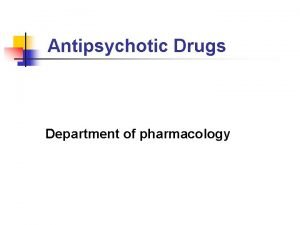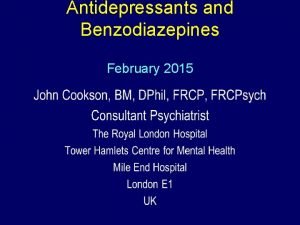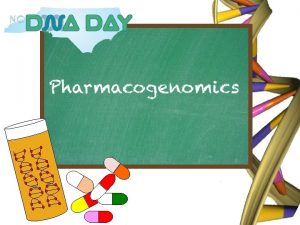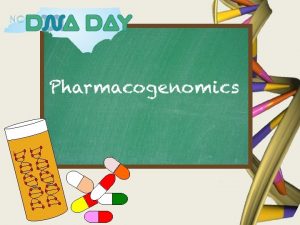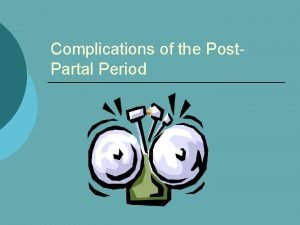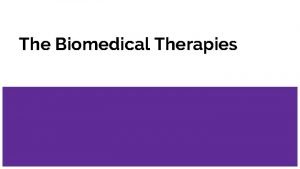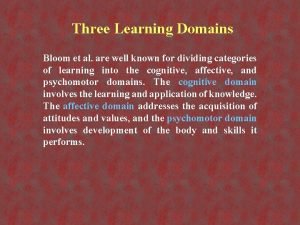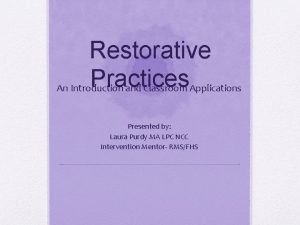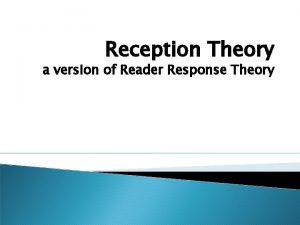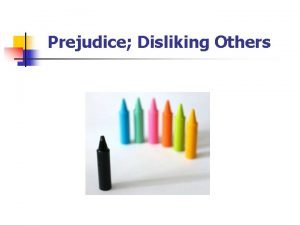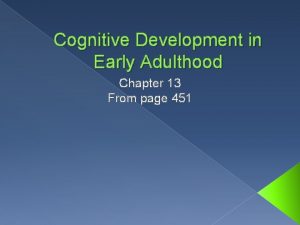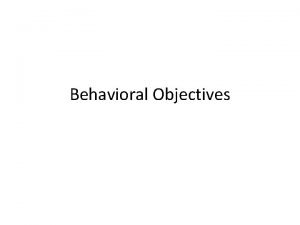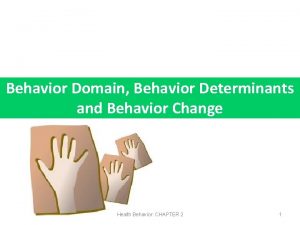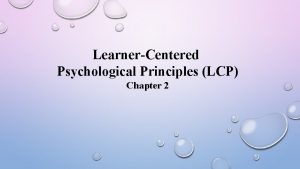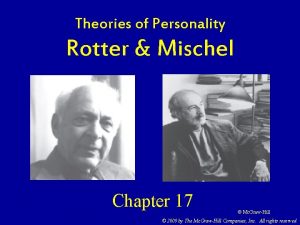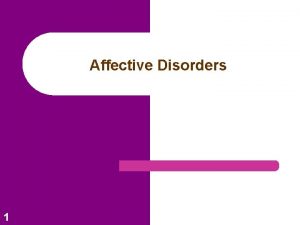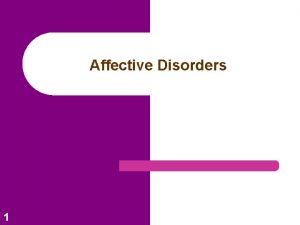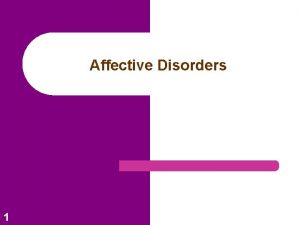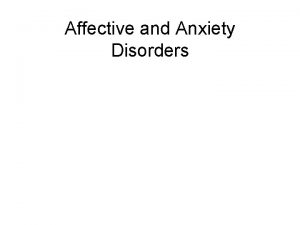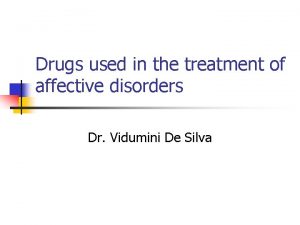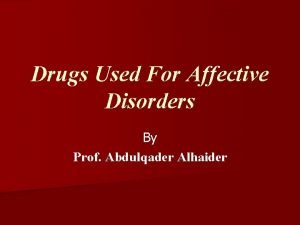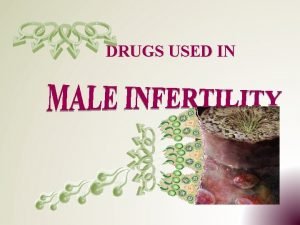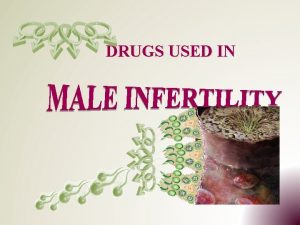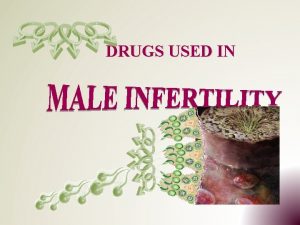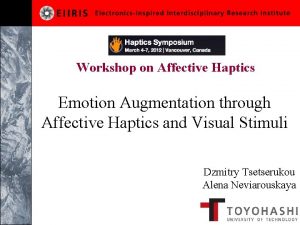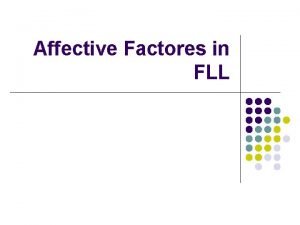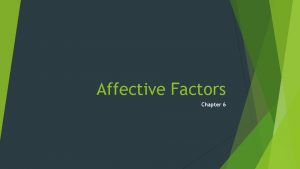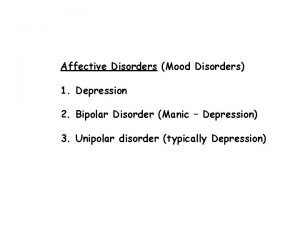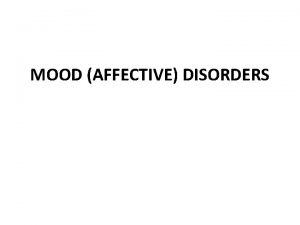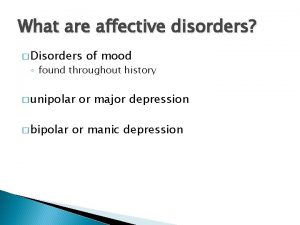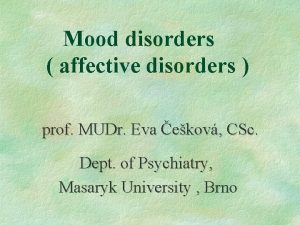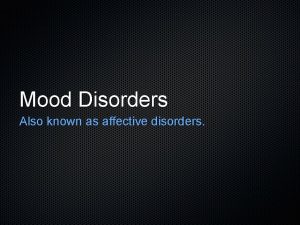Drugs Used in Treatment of Affective Disorders Antidepressant































- Slides: 31

Drugs Used in Treatment of Affective Disorders (Antidepressant Drugs) Dr. Shereen Ayoub Faculty of Medicine 1

Affective Disorders l Primary symptom is mood change; are common illnesses • • l l Depression – characterized by intense sadness, worry, agitation, physical changes Mania – characterized by elation, hyperactivity, and uncontrolled thought and speech Patients who suffers from depression alone or mania alone has a uni-polar illness. Patients who cycle back and forth between depression and mania have a bi-polar illness. 2

What are antidepressants? ? ? l l Drugs that are used to relieve or prevent psychic depression. Work by altering the way in which specific chemicals, called neurotransmitters, work in our brains (i. e. in the case of depression, some of the neurotransmitter systems don’t seem to be working properly). Acute effect: prevent reuptake of NT Chronic effect: down regulation of presynaptic inhibitory receptors leads to increase release of NT & enhance postsynaptic receptors to give therapeutic response. 3

Antidepressants Available in the Market (Worldwide)1 l 1) Tricyclics and Tetracyclics (TCA) Imipramine Clomipramine l Doxepin Amitriptyline Desipramine Nortriptyline Amoxepine Trimipramine Maprotiline Protriptyline 2) Monoamine Oxidase Inhibitors (MAOIs) Tranylcypramine Phenelzine Moclobemide l 3) Serotonin Selective Reuptake Inhibitors (SSRIs) Fluoxetine Fluvoxamine Sertraline Paroxetine. Citalopram l 4) Dual Serotonin and Norepinephrine Reuptake Inhibitor (SNRI) Venlafaxine l 5) Atypical antidepressant Nefazodone l Duloxetine Trazodone Bupropion Mirtazapi Carbamezapine Valproic acid 6) Treatment of Mania Lithium carbonate 4

Antidepressants l Specific serotonin reuptake inhibitors (SSRIs) • These are a relatively new class of antidepressants and have become drugs of first choice 5

Selective Serotonin Reuptake Inhibitors (SSRIs) l The SSRIs are currently the most widely utilized class of antidepressants in clinical practice. l They act within the brain to increase the amount of the neurotransmitter, serotonin (5 -hydroxytryptamine or 5 -HT), in the synaptic gap by inhibiting its reuptake. l Instead of being discovered by accident, SSRIs were specifically designed while considering the biological causes of depression. l SSRIs are described as 'selective' because they affect only the reuptake pumps responsible for serotonin, as opposed to earlier antidepressants, which affect other monoamine neurotransmitters as well. Because of this, SSRIs lack some of the side effects of the more general drugs. l Not cause CNS stimulation or mood elevation for normal individuals l Require 2 -12 weeks to work 6

Examples l l l Fluoxetine (Prozac) flu’ oxe teen Paroxetine (Paxil) par’ oxe teen Fluvoxamine (Luvox) flu vox’ meen Sertraline (Zoloft) ser’ tra leen Citalopram (Celexa) ci tal’ o pram and Escitalopram (Lexapro) es ci tal’ o pram 7

SSRI Drugs Fluoxetine l l Sertraline SSRI drugs include many of the popular drugs on the market today They include Fluoxetine (Prozac) and Sertraline (Zoloft). 8

Fluoxetine (Prozac) l l l Fluoxetine is a racemic mixture (50/50) of R-fluoxetine and S-fluoxetine enantiomers, where both enantiomers are specific and potent serotonin uptake inhibitors with essentially equivalent pharmacologic activity. But, the S-fluoxetine enantiomer is eliminated more slowly and is the predominant enantiomer present in plasma at steady state. The body eliminates Fluoxetine very slowly. The half-life of fluoxetine after a single dose is 2 days and after multiple dosing 4 days. The liver then metabolizes fluoxetine into norfluoxetine, a desmethyl metabolite, which is also a serotonin reuptake inhibitor; norfluoxetine has an even longer half-life, i. e. 8. 6 and 9. 3 days for single and repeated dosage respectively. Because fluoxetine's metabolism involves the P 450 IID 6 system, concomitant therapy with drugs also metabolized by this enzyme system (such as the tricyclic antidepressants) may lead to drug interactions. Hence, the complexity of the metabolism of fluoxetine has several consequences that may potentially affect fluoxetine's clinical use. 9

SSRIs Side Effects l l l a wide range of published interactions, notably with monoamine oxidase inhibitors. Common side-effects include GI-disturbance, anxiety, restlessness, trembling, weakness, skin rash, sexual dysfunction (treated with sildenafil, vardenafil, tadalafil), itching, sleep disturbance Fluoxetine overdose cause seizures, hyperthermia, muscle rigidity 10

SSRIs (cont. ) l l l Withdrawal syndrome can occur when short acting drugs stopped abruptly Can “unmask” mania in patients with bipolar disorder Paroxetine may induce birth defects 11

Sertraline (Zoloft) l Sertraline HCl is a selective serotonin reuptake inhibitor (SSRI) for oral administration. It is chemically unrelated to other SSRIs, tricyclic, tetracyclic, or other available antidepressant agents. l Sertraline undergoes extensive first pass metabolism. The principal initial pathway of metabolism for sertraline is N-demethylation. N-desmethylsertraline has a plasma terminal elimination half-life of 62 to 104 hours. 12

Serotonin and Noradrenaline Reuptake Inhibitors (SNRIs) l l Serotonin norepinephrine reuptake inhibitors (SNRIs) are a class of antidepressant used in the treatment of clinical depression and other affective disorders. They act upon two neurotransmitters in the brain that are known to play an important part in mood, namely, serotonin and norepinephrine. This can be contrasted with the more widelyused selective serotonin reuptake inhibitors (SSRIs), which act only on serotonin. SNRIs were developed more recently than SSRIs, and there are relatively few of them. Their efficacy as well as their tolerability appears to be somewhat better than the SSRIs, owing to their compound effect. These new drugs, because of their specificity for the serotonin and norepinephrine reuptake proteins, lack most of the adverse side effects of tricyclic antidepressants and monoamine oxidase inhibitors. 13

Venlafaxine (Effexor) cont’d l Venlafaxine and its active metabolite, O-desmethylvenlafaxine (ODV), are potent inhibitors of neuronal serotonin and norepinephrine reuptake and weak inhibitors of dopamine reuptake. Venlafaxine and ODV have no significant affinity for muscarinic, histaminergic, or a-1 adrenergic receptors l Venlafaxine is primarily metabolized by the cytochrome P 450 (CYP) 2 D 6 isoenzyme, with the CYP 3 A 3/4 system providing a secondary metabolic pathway. The drug only modestly inhibits CYP 2 D 6, and its metabolite has no effect on this isozyme. l Side effects may include nausea, dizziness, sleepiness, abnormal ejaculation, sweating, dry mouth, gas or stomach pain, abnormal vision, nervousness, insomnia, loss of appetite, constipation, confusion/agitation, tremors, and drowsiness. 14

SNRIs: Duloxetine l l Side effects may include nausea, dizziness, sleepiness, sexual dysfunction, vomitting, diarrhea, GI-upset. Not used for patients with hepatic dysfunction, half life 12 h. 15

Norepinephrine and Dopamine Reuptake Inhibitor (NDRI) l These are a class of antidepressants that are not really categorized as a special group of antidepressants (called atypical antidepressant). l Bupropion is a selective catecholamine (norepinephrine and dopamine) reuptake inhibitor. It has only a small effect on serotonin reuptake. It does not inhibit MAO. The actual mechanism behind bupropion's action is not known, but it is thought to be due to the effects on dopaminergic and noradrenergic mechanisms. Bupropion is metabolised in the liver. It has at 3 active metabolites; hydroxybupropion, threohydrobupropion and erythrohydrobupropion. These active metabolites are further metabolised to inactive metabolites and eliminated through excretion into the urine. The half-life of bupropion is 20 hours. l 16

Bupropion Side Effects l l l Common side effects include dry mouth, tremors, anxiety, loss of appetite, agitation, dizziness, headache, excessive sweating, increased risk of seizure, and insomnia. Bupropion causes less insomnia if it is taken just before going to bed. Sexual side effects normally accompanying SSRI's do not accompany bupropion. Use of bupropion limited due to possibility of convulsions. Bupropion under name Zyban used in smoking cessation. 17

Atypical antidepressant: Mirtazapine l l Mirtazapine: blocks 5 -HT 2 & α 2 receptor & antihistamine (sedative effect). Nefazodone & Trazodone : weak inhibitors of serotonin reuptake, block H 1 -receptor (sedating) 18

Tricyclic Antidepressants (TCAs) l l l Between 1960 and 1980 tricyclic antidepressants (TCAs) represented the major pharmacological treatment for depression. They have been considered a homogeneous group of drugs differing mostly in their potency to inhibit presynaptic norepinephrine or serotonin uptake and in their propensity for causing variety of unwanted effects. The TCAs induce anticholinergic, antihistaminergic, and cardiotoxic side effects which are related to their action on muscarinic (mainly M 1), histamine (H 1), adrenergic (α 1) receptors and cardiac Na+ and Ca 2+ channels. 19

Tricyclic Antidepressants l Examples • First Generation • Imipramine (Tofranil) • Desipramine (Norpramin) • Amitriptyline (Elavil) • Second Generation • Doxipen (Sinequan) • Maprotiline (Ludiomil) • Amoxapine (Asendin) 20

TCA Drugs l l l The first tricyclic antidepressant discovered was imipramine, which was discovered accidentally in a search for a new antipsychotic in the late 1950 s. Imipramine was used for bedwetting in children (alter than 6 y), but it causes cardiac arrhythmias (so now Not used) Imipramine is the prototypic tricyclic antidepressant utilized in the treatment of major depression and exerts its therapeutic efficacy only after prolonged administration Imipramine (Tofranil) 21

Amitriptyline (Elavil, Tryptanol, Endep) l l l Amitriptyline HCl is an antidepressant with sedative effects. Amitriptyline inhibits the membrane pump mechanism responsible for uptake of norepinephrine and serotonin in adrenergic and serotonergic neurons. Pharmacologically this action may potentiate or prolong neuronal activity since reuptake of these biogenic amines is important physiologically in terminating transmitting activity. This interference with the reuptake of norepinephrine and/or serotonin is believed by some to underlie the antidepressant activity of amitriptyline. It is used to treat pain without known cause Amitriptyline 22

Pharmacokinetics & Side Effects of TCAs l l Pharmacokinetics: well absorbed orally, lipophilic, first pass effect (low bioavailability), Fate by cyt-P 450 & conjugated & then excreted in urine Half life 4 -17 h, duration of therapy 4 -8 weeks The side effects of tricyclic antidepressant may include drowsiness, anxiety, restlessness, dry mouth, constipation, urinary retention or difficulty with urination, cognitive and memory difficulties, weight gain, sweating, dizziness, decrease in sexual ability and desire, muscle twitches, weakness, nausea, increased heart rate and irregular heart rhythms (rare). (anticholinergic properties). Percaution: in manic-depressive patients (No treatment for Manic), narrow therapeutic index 23

Monoamine Oxidase Inhibitors l Block metabolism of naturally occurring monoamines, e. g. , NE, 5 HT. Are used in the treatment of depression when tricyclics are not effective and ECT refused. • Agents • Tranylcypromine (Parnate) • Phenelzine (Nardil) 24

Monoamine Oxidase Inhibitors l Pharmacological properties • Mechanism of antidepressant action assumed to be related to inhibition of monoamine oxidase • CNS – direct stimulation similar to amphetamine • Cardiovascular system – interference with postural reflexes, changes in cardiac conduction 25

Monoamine Oxidase Inhibitors l Disposition • Oral absorption – good • Irreversible inhibition of MAO produces long lasting effects 26

Monoamine Oxidase Inhibitors l Adverse effects • Orthostatic hypotension • Central stimulation – tremors, insomnia • Overdose – agitation, hallucinations, • • convulsions, hypertensive crisis Constipation, weakness, fatigue, skin rash, difficulty in urination, inhibition of ejaculation, headache hepatotoxicity 27

Monoamine Oxidase Inhibitors l Drug interactions • Potentiate sympathomimetic amines • Dangerous interaction with tyramine (found in • food) Prolong the effects of tricyclics, central depressants, analgesics, anticholinergic agents 28

St. John’s Wort l l Herbal remedy for depression. Has not been evaluated by FDA. Contains compounds that inhibit MAO and block 5 HT reuptake. Drug interactions are a problem. Hyperforin, a P 450 inducer found in St. J. W. , increases metabolism of drugs used to treat AIDS and suppress transplant rejection. S-adenosyl-methionine (SAM): Dietary supplement for “emotional well being”. No good evidence to support efficacy as antidepressant. 29

Treatment of Mania & Bipolar disorder l l l 1. Lithium carbonate: prphylactically for manicdepressive patient MAO: via increase PIP 2 centrally, orally, excreted in urine, has narrow therapeutic index. SE: ataxia, tremors, confusion, dry mouth, DI (treted with amiloride), inhibition thyroid function. 2. Carbamezapine (Tegretol) & Valeproate (Depekene) are antiepeleptic drugs also used to treat depression & mania. 3. Manic episode – Olanzapine or risperidone added to mood stabilizer. 30

31
 Orthostatic hypotensin
Orthostatic hypotensin Snri vs ssri
Snri vs ssri Drug metabolism liver
Drug metabolism liver Adme
Adme What does infected lochia look like
What does infected lochia look like Mva/eva tray
Mva/eva tray Teratogens images
Teratogens images Biomedical therapy:
Biomedical therapy: 3 domains of learning
3 domains of learning Affective assessment tools
Affective assessment tools Family institution definition
Family institution definition Affective social action example
Affective social action example Collocative meaning in semantics examples
Collocative meaning in semantics examples Restorative circle ideas
Restorative circle ideas Psychological reader response theory
Psychological reader response theory Affective prejudice
Affective prejudice Solidarity social distance scale
Solidarity social distance scale Affective theory in literature
Affective theory in literature Examples of affective domain learning objectives
Examples of affective domain learning objectives Examples of affective domain learning objectives
Examples of affective domain learning objectives Examples of affective domain objectives in mathematics
Examples of affective domain objectives in mathematics Affective curriculum
Affective curriculum Affective states
Affective states Cognitive-affective complexity
Cognitive-affective complexity Objectives in lesson plan
Objectives in lesson plan Verbs for affective objectives in lesson plan
Verbs for affective objectives in lesson plan Affective domain verbs
Affective domain verbs Psychomotor objectives examples
Psychomotor objectives examples Behavior domains
Behavior domains Affective domain
Affective domain 14 learner centered psychological principles
14 learner centered psychological principles Rotter defined maladaptive behavior as behavior that
Rotter defined maladaptive behavior as behavior that
